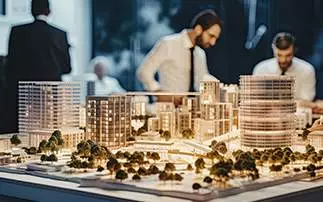Watershed Assessment and Management Plans: A Comprehensive Guide
A watershed is more than just a geographical feature. It represents a critical component of the hydrological cycle, where all the water—whether from rain or melting snow—eventually flows toward a common outlet, such as a river, lake, or ocean. Watersheds are vital in sustaining ecosystems and providing essential water resources for agriculture, industry, and communities. As development pressures rise, maintaining the health of watersheds has become more critical than ever. This is where effective watershed assessment and management plans come into play.
ASI specializes in creating Natural Asset Management Plans for watersheds, guiding stakeholders through the entire process of managing these resources—from initial assessment to long-term maintenance. Let’s understand what makes a successful watershed management plan.

1. Watershed Assessment
A thorough watershed assessment forms the backbone of the management plan, involving detailed hydrological, ecological, and land-use analysis. This includes:
- Hydrological Modeling: Advanced tools like GIS (Geographic Information Systems) and hydrological models (e.g., SWAT, HSPF) are employed to simulate water flow patterns, surface runoff, and groundwater interactions within the watershed. These models help assess the potential impacts of various land-use changes on water availability and quality.
- Water Quality Monitoring: A range of physical, chemical, and biological parameters are tested to determine the watershed’s current health. For example, indicators like turbidity, dissolved oxygen (DO), nutrient levels (nitrogen, phosphorus), and the presence of heavy metals or harmful microorganisms (E. coli, coliform) are critical for understanding pollution levels.
- Ecological Surveys: Ecological conditions are evaluated by assessing biodiversity, vegetation cover, and habitat integrity. This often includes species inventories, particularly for endangered or keystone species, and vegetation mapping to assess habitat fragmentation.
Data from these assessments enable the identification of problem areas, such as erosion hotspots, polluted water bodies, or compromised habitats, guiding the next steps in the management process.
2. Stakeholder Engagement
Effective watershed management requires the integration of diverse stakeholders, including government bodies, environmental organizations, industries, and local communities. Stakeholder engagement is achieved through:
- Public Participation: Engaging communities in the decision-making process ensures the incorporation of local knowledge and builds public support for management initiatives. Techniques like stakeholder workshops, surveys, and public consultations are used to gather input on issues like land use, water rights, and conservation priorities.
- Interagency Collaboration: Coordination among local, provincial, and national agencies is vital for aligning regulatory standards, such as the Clean Water Act or Safe Drinking Water Act. Collaboration allows for sharing resources and expertise, ensuring a unified approach to watershed management.
- Industrial Involvement: Industries such as agriculture, forestry, and mining are significant stakeholders due to their impact on land and water use. Engaging these industries ensures that best practices are implemented, reducing pollution and enhancing resource sustainability.
3. Goal Setting
Technical objectives are established based on the watershed assessment and stakeholder input, with measurable targets to guide the implementation process. Goals might include:
- Water Quality Improvement Targets: Reducing pollutants like nitrates, phosphates, and suspended solids by a specific percentage over a defined period.
- Flood Risk Mitigation: Implementing hydrological modifications (e.g., retention basins, floodplain restoration) to reduce peak stormwater flows and improve drainage systems to manage runoff more effectively.
- Habitat Restoration: Setting targets for increasing forest cover, wetland restoration, or riparian buffer zones to improve biodiversity and stabilize ecosystems.
Each goal should be backed by measurable metrics and time-bound milestones, allowing for a clear evaluation of success over time.
4. Best Management Practices (BMPs)
BMPs are industry-proven strategies designed to address the specific challenges identified during the watershed assessment. Technical BMPs are categorized as structural, non-structural, and vegetative:
- Structural BMPs: Include engineered solutions such as stormwater detention basins, permeable pavements, and constructed wetlands. These interventions manage runoff, reduce flooding, and improve water infiltration. For example, green roofs and rain gardens are increasingly used in urban areas to reduce impervious surface impacts and mitigate stormwater runoff.
- Non-structural BMPs: These involve policy-based or management-focused approaches, such as zoning regulations, land-use planning, and pollution control programs. Agricultural BMPs, like controlled livestock access to water bodies or nutrient management plans, minimize runoff and protect water quality.
- Vegetative BMPs: Vegetation plays a critical role in watershed health by stabilizing soils, filtering pollutants, and providing habitat. Riparian buffer strips, reforestation, and cover cropping are vegetative BMPs that help prevent erosion and improve ecosystem health.
BMPs must be selected and implemented based on site-specific conditions and hydrological modelling outcomes, ensuring they effectively address the identified watershed challenges.
5. Monitoring and Evaluation
Continuous monitoring and adaptive management are essential to ensure the long-term success of watershed management plans. The process typically involves:
- Real-time Data Collection: Modern technologies like remote sensing, satellite imagery, and water quality sensors provide real-time data on key watershed indicators. These systems monitor land use, pollution levels, and water flow changes, providing actionable insights for decision-makers.
- Performance Metrics: Monitoring includes tracking KPIs (Key Performance Indicators) such as pollutant load reductions, biodiversity improvements, or flood frequency reductions. Performance metrics should align with the established goals and help evaluate the effectiveness of the BMPs in place.
- Adaptive Management: Based on the data collected, strategies can be adjusted to address unforeseen challenges or evolving conditions. This ensures that the management plan remains responsive and effective as environmental and regulatory conditions change.
6. Education and Outreach
A successful watershed management plan requires active participation and understanding from all levels of society, including industry professionals, local governments, and community members. Educational initiatives include:
- Technical Training for Professionals: Offering specialized training for industry professionals on hydrological modelling, BMP implementation, and water quality assessment helps ensure that those managing the watershed are equipped with the latest tools and knowledge.
- Public Awareness Campaigns: Community outreach programs focus on increasing awareness about watershed health and the importance of sustainable practices. Public involvement can significantly enhance compliance with regulations and BMPs, especially in agriculture and urban development sectors.
- Industry-Specific Workshops: Hosting workshops focused on industry-specific BMPs and regulatory requirements ensures that businesses operating within the watershed are informed of their responsibilities and equipped to implement sustainable practices.
Wrapping it up
If you want to develop a tailored watershed management plan or need expert guidance, contact ASI at info@AssetStrategyInc.com to discuss how we can support your goals.
Condition Assessments of Physical Assets
Condition assessments systematically evaluate an asset’s physical state and performance to ensure reliability, safety, and…
The Importance of Asset Management for Buildings
Building Condition Reports (BCR) and Climate Risk and Vulnerability Assessments (CRVA) are crucial for maintaining structures’ safety…
Experts in Municipal Decarbonization and Energy Reduction Strategies
The push for sustainability has never been more critical, especially for municipalities seeking to lower their carbon footprint…


